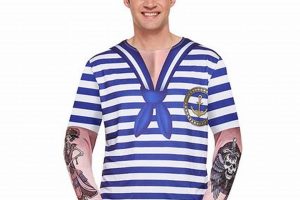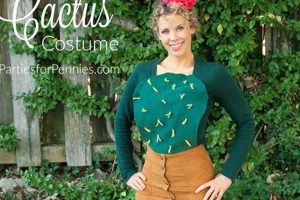Creating a homemade Mike Wazowski outfit represents a do-it-yourself approach to character portrayal, specifically focusing on the iconic, one-eyed monster from Pixar’s Monsters, Inc.. This method involves crafting a recognizable representation of the character using readily available materials and personal artistic skills, resulting in a unique and personalized costume. An example includes fashioning a spherical green body from fabric, adding a large, central eye, and completing the look with appropriate accessories.
The value of constructing such a costume lies in its affordability, creative expression, and customizability. Compared to purchasing a pre-made costume, the do-it-yourself approach often provides significant cost savings. Furthermore, it offers an outlet for creativity and allows for a tailored fit and design, ensuring a personalized and potentially more visually striking representation. Historically, homemade costumes have been a staple of celebrations and events, enabling individuals to participate in character portrayal without substantial financial investment.
The subsequent sections will provide detailed instructions and inspiration for developing a successful and recognizable version of the aforementioned outfit. Considerations for material selection, construction techniques, and accessory options will be addressed to guide the crafting process from initial concept to final execution.
Crafting a Successful Mike Wazowski Costume
Achieving a recognizable and durable recreation of the Mike Wazowski character necessitates careful planning and execution. The following guidelines offer strategies for maximizing the impact and longevity of the homemade design.
Tip 1: Prioritize Spherical Structure: The character’s rotund form is instantly recognizable. Implement pattern-making techniques, such as creating a geodesic dome shape, to achieve a smooth, round silhouette. Consider using lightweight materials like foam or inflated structures to maintain shape and comfort.
Tip 2: Fabric Selection is Critical: Opt for a vibrant, consistent shade of green fleece or felt. These materials are easy to work with, provide a soft texture, and photograph well. Avoid materials that wrinkle easily or lack opacity, as these can detract from the overall appearance.
Tip 3: The Eye is Paramount: Construct the central eye meticulously. A large, rigid white disc with a detailed iris and pupil provides the greatest visual impact. Consider using a translucent material for the iris to allow for internal lighting or visual depth.
Tip 4: Consider Visibility and Comfort: Incorporate breathable fabrics and strategically placed openings to ensure wearer comfort and visibility. Mesh panels around the lower portion of the sphere can provide ventilation and a wider field of vision without compromising the costume’s aesthetic.
Tip 5: Implement Secure Attachment Systems: Devise a robust harness or suspension system within the costume to distribute weight evenly and prevent slippage. Adjustable straps and reinforced seams are crucial for maintaining structural integrity throughout extended wear.
Tip 6: Accurate Limb Proportion: Replicating the character’s slender limbs requires attention to detail. Fabric tubes filled with lightweight batting or foam can effectively mimic the arm and leg structure. Ensure these appendages are securely attached to the main body.
Tip 7: Durability Reinforcement: Reinforce all seams and stress points with sturdy stitching or adhesive bonding to prevent tearing or deformation. This is particularly important in areas that will experience frequent movement or contact.
Successful application of these tips will significantly enhance the quality, durability, and overall visual impact of the constructed costume, resulting in a more accurate and impressive portrayal of the character.
The subsequent section will explore advanced techniques for incorporating special effects and unique design elements into the aforementioned costume.
1. Shape Accuracy
Shape accuracy constitutes a critical determinant in the successful realization of a Mike Wazowski costume through do-it-yourself methods. Given the character’s distinctive, spherical form, deviations from accurate shape representation can severely compromise the costume’s recognizability and overall aesthetic appeal.
- Pattern Design
Precise pattern design forms the foundation of shape accuracy. Employing established techniques such as geodesic dome construction or adapting pre-existing spherical patterns facilitates the creation of a foundational structure that closely resembles the character’s body shape. Inaccurate pattern creation inevitably leads to a distorted and less recognizable costume. Proper pattern development should account for material thickness and seam allowances to ensure the final shape remains consistent with design specifications.
- Material Rigidity and Support
The selected material and its inherent rigidity significantly impact shape maintenance. Flaccid or excessively pliable materials require internal support structures to prevent sagging or deformation, thereby preserving the intended spherical shape. Options for support include wire framing, foam padding, or inflatable bladders. Inadequate support results in a costume that loses its intended shape over time, diminishing its visual impact. A balanced approach, considering both material properties and support systems, is crucial.
- Seam Placement and Construction
The placement and construction of seams play a vital role in achieving a smooth, uniform surface. Improper seam placement can create unsightly bulges or indentations that disrupt the overall spherical form. Employing techniques such as dart manipulation or curved seam lines minimizes such distortions. Secure and even seam stitching also contributes to the structural integrity of the costume, preventing localized collapse or deformation that compromises shape accuracy.
- Scale and Proportion
Accurate scaling and proportional representation are essential for maintaining visual consistency. The relationship between the overall diameter of the spherical body and the size of key features, such as the eye and limbs, must adhere to established character design guidelines. Disproportionate elements can create a jarring and visually unappealing costume, hindering accurate character portrayal. Attention to scale and proportion ensures a cohesive and recognizable representation.
These facets of shape accuracy demonstrate its fundamental importance in the construction of a credible Mike Wazowski costume through do-it-yourself processes. Neglecting any of these areas negatively affects the final product, highlighting the necessity of careful planning and execution to achieve the desired result.
2. Material Choice
Material selection constitutes a pivotal determinant in the success of a Mike Wazowski costume created through do-it-yourself methods. The chosen materials directly influence the costume’s aesthetic appeal, comfort level, durability, and overall recognizability. Inappropriate material selection can result in a visually inaccurate, uncomfortable, or structurally unsound costume, thereby undermining the overall objective. For instance, utilizing a stiff, non-breathable material for the spherical body could yield a visually rigid but uncomfortable and potentially hazardous costume, especially during extended wear or in warmer environments. Conversely, a material lacking sufficient structure might result in a shapeless and unrecognizable representation of the character.
Specific material properties, such as colorfastness, texture, and weight, also contribute significantly. A vibrant, consistent green fabric, such as fleece or felt, effectively captures the character’s characteristic hue. These materials are generally easy to work with, readily available, and offer a soft texture conducive to comfort. Conversely, a thin, translucent fabric could compromise the costume’s opacity and visual integrity, necessitating additional layering or reinforcement. Furthermore, the material’s weight impacts wearability, with lighter materials generally preferred for extended periods. The material used for the eye component is also critical, with rigid foams or plastics often employed to maintain its shape and provide a smooth surface for painting or detailing. Improper material choice for the eye, such as using flexible fabric, would lead to distortion and diminish the costume’s accuracy.
In conclusion, careful consideration of material properties is paramount in the do-it-yourself creation of a Mike Wazowski costume. The chosen materials directly impact the costume’s aesthetic, comfort, durability, and recognizability. A thorough understanding of the characteristics of various materials enables informed decision-making, leading to a superior final product. Selecting the right materials presents challenges, such as balancing cost with quality and ensuring material compatibility. However, overcoming these challenges through informed selection is essential for a successful and satisfying outcome.
3. Eye Construction
The construction of the eye holds paramount importance within the context of a homemade Mike Wazowski costume. Given the character’s defining feature a singular, large eye its accurate and effective representation directly dictates the costume’s recognizability and overall success. Flawed eye construction compromises the immediate identification of the character. A disproportionate or poorly rendered eye, for instance, distracts from the overall costume and negates the effort invested in other areas. A real-world example includes instances where amateur costumes, despite meticulous body construction, fail due to a small, poorly shaped, or incorrectly colored eye.
Effective eye construction necessitates a multi-faceted approach. The chosen material must possess sufficient rigidity to maintain its shape, while also being amenable to detailed painting or embellishment. Rigid foams, plastics, or layered cardstock often serve as suitable bases. Accurate scaling and proportion are also essential; the eye’s size relative to the costume’s body must adhere to the established character design. Furthermore, the rendering of the iris and pupil requires careful attention to detail, with accurate color matching and precise execution of the characteristic pupil shape. A well-constructed eye enhances the costume’s visual impact, drawing the viewer’s attention and solidifying the portrayal of the character. Techniques like painting with acrylics and sealing with varnish may be employed. Improper sealing, for instance, can lead to paint chipping and degradation of the costumes aesthetic value.
In summation, careful and precise execution of eye construction represents a non-negotiable element in the do-it-yourself creation of a Mike Wazowski costume. The eye’s visual prominence dictates the immediate recognizability and overall effectiveness of the costume. Addressing challenges related to material selection, accurate scaling, and detailed rendering proves crucial for achieving a successful portrayal. Therefore, dedication to achieving a well-constructed and accurate eye is necessary to create a successful Mike Wazowski costume.
4. Comfort
The intersection of comfort and homemade Mike Wazowski attire presents a critical consideration for costume design. The act of crafting a visually accurate representation of the character must coexist with the wearer’s physical well-being. Neglecting comfort factors during the do-it-yourself process directly impacts the duration the costume can be worn, the wearer’s enjoyment, and the overall success of the endeavor. A visually stunning costume rendered unbearable due to poor ventilation, restricted movement, or abrasive materials fails to achieve its intended purpose. For instance, a costume constructed from rigid, non-breathable material may accurately replicate the character’s form but quickly lead to overheating and discomfort, limiting its use. Similarly, an ill-fitting design that restricts arm movement or causes chafing significantly diminishes the wearer’s experience.
Material selection, structural design, and internal support systems directly influence comfort. Breathable fabrics, such as fleece or cotton blends, promote airflow and minimize perspiration build-up. A spacious interior allows for unrestricted movement, while strategically placed openings provide ventilation. The weight distribution across the wearer’s body also requires careful consideration. An uneven weight distribution can lead to strain and fatigue. Harness systems or internal supports should distribute the weight evenly, mitigating discomfort and allowing the wearer to maintain the costume for extended periods. Internal padding within the costume absorbs movement and prevents abrasion from rigid components. Considerations for accessibility, such as ease of donning and removal, also contribute to the overall comfort and practicality of the homemade design.
In summary, comfort represents an indispensable element in successful creation of a Mike Wazowski costume through do-it-yourself methods. Balancing visual accuracy with the wearer’s physical well-being requires careful planning and material selection. Challenges related to material breathability, freedom of movement, and weight distribution must be addressed to ensure a wearable, enjoyable, and ultimately successful costume. Prioritizing comfort directly translates to increased wear time, wearer satisfaction, and a more effective and engaging portrayal of the character.
5. Mobility
Mobility represents a significant constraint within the realm of homemade Mike Wazowski costumes. The character’s spherical body, inherently restrictive, presents considerable challenges to uninhibited movement. Construction methods neglecting mobility factors invariably yield costumes unsuitable for active use. Reduced agility and maneuverability create a practical impediment to navigating crowded spaces or participating in typical costume-wearing
activities. For instance, a rigid, fully enclosed spherical structure severely limits the wearer’s ability to walk, turn, or raise arms, increasing the risk of collisions and hindering interaction with others. The effect is a diminished ability to participate effectively in events where costumed characters are expected to engage with the audience or move freely.
Mitigating mobility limitations necessitates strategic design choices and construction techniques. Segmented body construction, incorporating flexible joints or articulated panels, allows for a wider range of motion. Openings for limb movement, carefully integrated into the costume’s design, provide necessary flexibility without compromising visual accuracy. Lightweight materials and internal support structures reduce overall weight and distribute it evenly, alleviating strain and improving balance. Consideration of visual obstructions, created by the costume’s bulk, is also essential. Incorporating methods to improve visibility, such as strategically placed viewing ports or head positioning relative to the costume’s center of gravity, enables safer navigation. A real-world example is the use of hula hoops layered with flexible fabric to create a spherical shape, allowing for movement while maintaining the character’s iconic form.
In summary, the degree of mobility incorporated directly impacts the practicality and usability of the crafted costume. While visual accuracy is paramount, neglecting mobility constraints leads to a limited and potentially hazardous garment. Successful integration of design elements promoting mobility enables the wearer to engage fully in costume-wearing activities, realizing the potential of a well-executed, homemade design. Overcoming these limitations necessitates a focus on flexible construction methods and carefully considered design adjustments, ensuring the final product remains both visually appealing and practically functional.
6. Detailing
Detailing, within the context of a Mike Wazowski costume crafted through do-it-yourself methods, refers to the precise and nuanced addition of features and embellishments that elevate the costume from a basic representation to a visually compelling and recognizable portrayal. It is through meticulous detailing that a homemade creation transcends a generic form and embodies the specific characteristics of the character.
- Horn Replication
The accurate replication of Mike Wazowski’s horns represents a crucial detailing aspect. The size, shape, and texture of the horns contribute significantly to the character’s silhouette and distinguish it from generic monster representations. Examples of successful horn construction include the use of lightweight foam sculpted and painted to match the character’s distinctive color. Conversely, inaccurate or poorly constructed horns detract from the costume’s overall realism and reduce its recognizability. The implications of horn detailing extend to structural integrity as well; poorly attached horns risk detaching during wear, diminishing the costume’s appeal.
- Mouth and Facial Expression
The depiction of Mike Wazowski’s mouth and implied facial expression forms another essential detailing element. This feature conveys the character’s personality and adds depth to the costume. Options range from simple painted representations to more elaborate three-dimensional constructions. Successful implementation of this detail might involve shaping a flexible foam to create a slightly open-mouthed expression. In contrast, a blank or poorly defined mouth fails to capture the character’s expressiveness, resulting in a static and less engaging costume. The impact of mouth detailing influences audience perception and contributes to the costume’s overall charisma.
- Textural Enhancement
The incorporation of textural enhancement, through the strategic application of materials and techniques, enhances the costume’s visual depth and realism. The use of varying fabric textures, such as smooth fleece for the body and slightly rougher felt for the limbs, adds subtle nuances that elevate the overall design. Examples of effective textural detailing include the addition of subtle shading around the eye or the incorporation of slight variations in the fabric’s surface. Conversely, a lack of textural variation results in a flat and uninspired costume. The implications of textural enhancement extend to tactile appeal as well; well-chosen textures invite interaction and contribute to a more engaging experience.
- Color Accuracy and Shading
Accurate color matching and strategic shading are essential aspects of detailing that contribute significantly to the realism and visual impact of the costume. Precise color matching to the character’s distinctive green hue enhances recognizability. The addition of subtle shading, particularly around the edges and curves of the spherical body, creates depth and dimension. Examples of effective color and shading application include the use of airbrushing techniques to create subtle gradations in color. Conversely, inaccurate color matching or a lack of shading results in a flat and less visually appealing costume. The impact of color and shading extends to photographic representation as well; well-shaded costumes translate more effectively in photographs, enhancing their overall appeal.
Ultimately, detailing represents a critical layer in the process of creating a successful Mike Wazowski costume through do-it-yourself methods. It bridges the gap between a basic representation and a compelling portrayal, significantly influencing the costume’s recognizability, visual appeal, and overall effectiveness. The meticulous execution of details elevates the entire costume.
Frequently Asked Questions
The following questions address common concerns and misconceptions regarding the creation of a Mike Wazowski costume through do-it-yourself methods. These answers aim to provide clear, informative guidance for individuals undertaking this project.
Question 1: What is the most effective method for achieving a spherical shape for the costume’s body?
The utilization of geodesic dome construction techniques, involving the creation of interconnected triangular panels, offers a structurally sound and visually accurate approach. Alternatively, inflatable structures or layered foam padding can provide a lighter-weight and more adaptable solution.
Question 2: Which materials provide the optimal balance of comfort, durability, and visual appeal for a Mike Wazowski costume?
Fleece and felt fabrics offer a combination of softness, ease of handling, and vibrant color rendition. For structural components, rigid foams or plastics provide the necessary support and shape retention. Breathable linings are essential for maximizing wearer comfort during extended use.
Question 3: What are the key considerations in constructing a realistic and visually striking single eye?
Accuracy in size and proportion, relative to the costume’s overall scale, is paramount. The use of rigid materials, such as acrylic or plastic, ensures shape stability. Detailed painting or application of vinyl decals captures the character’s distinctive iris and pupil. Consider incorporating internal lighting for enhanced visual impact.
Question 4: How can one mitigate mobility restrictions imposed by the costume’s spherical shape?
Implementing segmented construction, incorporating flexible joints or articulated panels, allows for a greater range of motion. Strategic placement of openi
ngs for limb movement provides necessary flexibility. Lightweight materials and internal support structures reduce overall weight and improve balance.
Question 5: What strategies can be employed to enhance the costume’s comfort during extended wear?
Breathable linings, such as moisture-wicking fabrics, promote airflow and minimize perspiration build-up. A spacious interior allows for unrestricted movement. Internal padding absorbs impact and prevents abrasion. Even weight distribution, achieved through a well-designed harness system, reduces strain and fatigue.
Question 6: How does one ensure the homemade Mike Wazowski costume maintains structural integrity and durability over time?
Reinforcing all seams with sturdy stitching or adhesive bonding prevents tearing or deformation. Selecting high-quality materials with inherent resistance to wear and tear extends the costume’s lifespan. Proper storage practices, such as avoiding excessive compression or exposure to extreme temperatures, further contribute to longevity.
These FAQs highlight critical factors influencing the success of a do-it-yourself Mike Wazowski costume project. Addressing these concerns proactively streamlines the construction process and enhances the final outcome.
The subsequent section will delve into advanced customization options for enhancing the uniqueness of one’s costume.
Concluding Remarks on Mike Wazowski Costume DIY
The preceding exploration elucidated critical facets governing the effective execution of a Mike Wazowski costume DIY project. Key elements included shape accuracy, material selection, eye construction, comfort considerations, mobility constraints, and the impact of detailing. Successful navigation of these aspects dictates the recognizability, wearability, and overall visual impact of the resulting costume. Emphasis was placed on informed decision-making regarding materials, construction techniques, and design adjustments to reconcile aesthetic aspirations with practical limitations.
Mastery of the Mike Wazowski costume DIY process necessitates a commitment to both creative expression and rigorous attention to detail. While the challenges inherent in replicating a complex character design are considerable, the potential for personalized artistic interpretation remains substantial. Continued refinement of techniques and exploration of innovative materials will undoubtedly yield increasingly sophisticated and compelling homemade representations. This process serves not only as a means of costumed self-expression but also as a testament to the power of resourcefulness and ingenuity in realizing creative visions.







